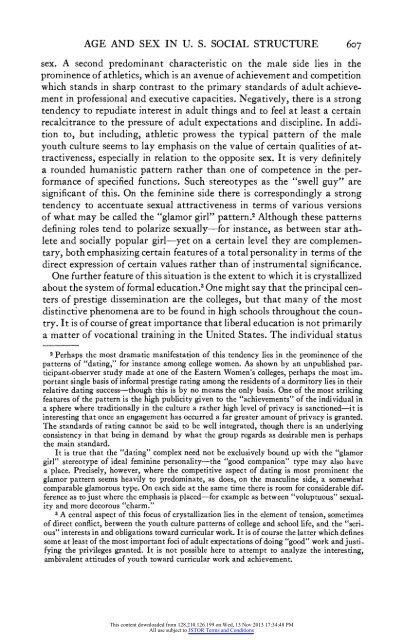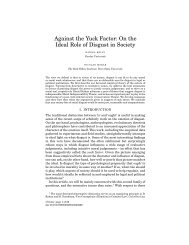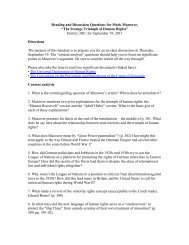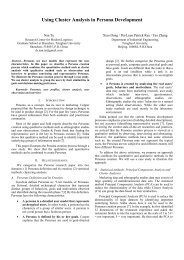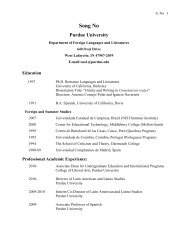Parsons 1942 - Career Account Web Pages
Parsons 1942 - Career Account Web Pages
Parsons 1942 - Career Account Web Pages
Create successful ePaper yourself
Turn your PDF publications into a flip-book with our unique Google optimized e-Paper software.
AGE AND SEX IN U. S. SOCIAL STRUCTURE 607<br />
sex. A second predominant characteristic on the male side lies in the<br />
prominence of athletics, which is an avenue of achievement and competition<br />
which stands in sharp contrast to the primary standards of adult achievement<br />
in professional and executive capacities. Negatively, there is a strong<br />
tendency to repudiate interest in adult things and to feel at least a certain<br />
recalcitrance to the pressure of adult expectations and discipline. In addition<br />
to, but including, athletic prowess the typical pattern of the male<br />
youth culture seems to lay emphasis on the value of certain qualities of attractiveness,<br />
especially in relation to the opposite sex. It is very definitely<br />
a rounded humanistic pattern rather than one of competence in the performance<br />
of specified functions. Such stereotypes as the "swell guy" are<br />
significant of this. On the feminine side there is correspondingly a strong<br />
tendency to accentuate sexual attractiveness in terms of various versions<br />
of what may be called the "glamor girl" pattern.2 Although these patterns<br />
defining roles tend to polarize sexually-for instance, as between star athlete<br />
and socially popular girl-yet on a certain level they are complementary,<br />
both emphasizing certain features of a total personality in terms of the<br />
direct expression of certain values rather than of instrumental significance.<br />
One further feature of this situation is the extent to which it is crystallized<br />
about the system of formal education.3 One might say that the principal centers<br />
of prestige dissemination are the colleges, but that many of the most<br />
distinctive phenomena are to be found in high schools throughout the country.<br />
It is of course of great importance that liberal education is not primarily<br />
a matter of vocational training in the United States. The individual status<br />
2<br />
Perhaps the most dramatic manifestation of this tendency lies in the prominence of the<br />
patterns of "dating," for instance among college women. As shown by an unpublished participant-observer<br />
study made at one of the Eastern Women's colleges, perhaps the most important<br />
single basis of informal prestige rating among the residents of a dormitory lies in their<br />
relative dating success-though this is by no means the only basis. One of the most striking<br />
features of the pattern is the high publicity given to the "achievements" of the individual in<br />
a sphere where traditionally in the culture a rather high level of privacy is sanctioned-it is<br />
interesting that once an engagement has occurred a far greater amount of privacy is granted.<br />
The standards of rating cannot be said to be well integrated, though there is an underlying<br />
consistency in that being in demand by what the group regards as desirable men is perhaps<br />
the main standard.<br />
It is true that the "dating" complex need not be exclusively bound up with the "glamor<br />
girl" stereotype of ideal feminine personality-the "good companion" type may also have<br />
a place. Precisely, however, where the competitive aspect of dating is most prominent the<br />
glamor pattern seems heavily to predominate, as does, on the masculine side, a somewhat<br />
comparable glamorous type. On each side at the same time there is room for considerable difference<br />
as to just where the emphasis is placed-for example as between "voluptuous" sexuality<br />
and more decorous "charm."<br />
3 A central aspect of this focus of crystallization lies in the element of tension, sometimes<br />
of direct conflict, between the youth culture patterns of college and school life, and the "serious"<br />
interests in and obligations toward curricular work. It is of course the latter which defines<br />
some at least of the most important foci of adult expectations of doing "good" work and justifying<br />
the privileges granted. It is not possible here to attempt to analyze the interesting,<br />
ambivalent attitudes of youth toward curricular work and achievement.<br />
This content downloaded from 128.210.126.199 on Wed, 13 Nov 2013 17:34:48 PM<br />
All use subject to JSTOR Terms and Conditions


